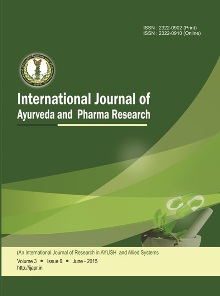PRELIMINARY PHARMACOGNOSTICAL, PHYTOCHEMICAL STUDY AND HPTLC ANALYSIS OF COSTUS PICTUS D.DON.
Abstract
The ancient wisdom in Ayurveda medicine is still not exhaustively explored. Multiple exotic plants existent in India which are not described in classical literature of Ayurveda are commonly referred to as Anukta Dravya (undocumented). Costus pictus D.Don is such a plant, recently introduced in India from Mexico, which is used for renal disorders there. In India, it is used in Diabetes mellitus. This is proven for antidiabetic, antioxidant, anticancerous, antimicrobial and diuretic actions. It is an easily propagated, palatable and cost effective plant. Identification through pharmacognostical and phytochemical studies is essential for the standardization of any plant. The green leaf is narrowly elliptic with 10 to 25cm length and 2.5 to 6cm width. Microscopy revealed presence of vascular bundles, unicellular trichomes in upper epidermis, thin walled parenchyma cells in ground tissue and layers of parenchymatous hypodermis. Powder microscopy showed presence of epidermal parenchyma cells with underlying chlorenchyma group of fibers and fibro vascular bundles.TLC photo documentation revealed presence of many phytoconstituents with different Rf values. Densitometric scan showed many peaks, 10 at 254nm, 11 at 366nm, 6 at 520nm and 9 at 620 nm after derivatisation. Moisture content was 20%. The percentage of total ash, acid insoluble ash, and water insoluble ash was determined. The water soluble extractive value was 22.57 which is highest among all the extracts. The results indicated the presence of alkaloid, steroids, tannins, flavanoids, phenol, carbohydrate and resin in ethanolic extract and steroid, flavanoids, phenols, saponins, tannins and glycosides in water extract.
Downloads

Copyright (c) 2021 International Journal of Ayurveda and Pharma Research

This work is licensed under a Creative Commons Attribution-NonCommercial-ShareAlike 4.0 International License.






